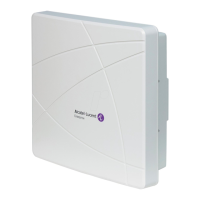All rights
reserved. Passing on and copying of this document, use and
communication of its contents not permitted without written authorization from
HAN-Networks.
Adjacent APs need to use different radio channels to prevent interference between
them. See Channel and Transmission power Considerations.
Cohabitation with DECT APs
Place WLAN APs at least 3.5 meters from DECT APs in order not to disturb DECT
communications.
3.1.4 Channel and Transmission power Considerations
Adjacent APs need to use different radio channels to prevent interference between
them. The 802.11b/g/n standard provides for three non-interfering channels:
channels 1, 6, and 11. APs within range of each other should always be set to non-
interfering channels to maximize the capacity and performance of the wireless
infrastructure, as shown in the diagram below.
If adjacent APs are set to the same channel, or use channels with overlapping
frequency bands, the resulting interference will cause a significant reduction in the
network performance and throughput, and will degrade overall voice quality.
In an 802.11a/n deployment, all 23 channels are considered non-overlapping, since
there is 20 MHz of separation between the center frequencies of each channel.

